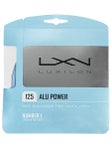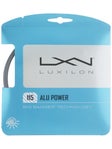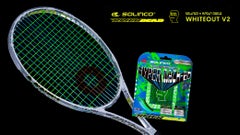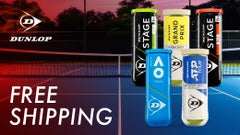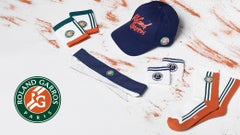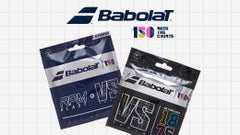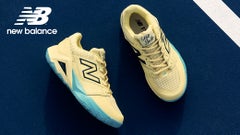Luxilon ALU Power vs. Luxilon Savage String Comparison Review
We test the legendary Luxilon ALU Power alongside the more budget friendly Luxilon Savage to see how they stack up against each other in terms of power, control, spin, feel and playability duration. Which one is right for you?
Although polyester monofilaments have been around since the 1970s, many players believe Luxilon perfected the breed in the late '90s with ALU Power, a string renowned for its legendary achievements in the world of professional tennis. By contrast, Luxilon Savage, a stiff six-sided co-poly, has operated in relative obscurity, overshadowed by its iconic counterpart. Comparing these strings raises an inescapable question: Can Savage, Luxilon's budget-friendly option, hold its own against what many consider the GPOAT (greatest poly of all time)? To find out, our playtest team has analyzed these strings across several performance categories. Let's delve into the results.
Specs
| ALU Power | Savage | |
| Gauge | 1.25mm | 1.27mm |
| Shape | Round | Hexagon |
| Composition | Co-polyester monofilament | Co-polyester monofilament |
| Stiffness* | 209 | 234 |
| Price | $19.95 | $9.95 |
*Stiffness measured by the Tennis Warehouse University
Power/Control
To truly understand a string's performance, we must consider its stiffness, which not only affects where a string falls on the power-control spectrum, but also determines the amount of shock and vibration that reaches your arm. Although both ALU Power and Savage have similar constructions, Savage is 15 percent stiffer than ALU Power, which translates to less ball speed off the stringbed (think control). As such, Savage proved perfect for Michelle, who prefers to create her own power. She said, "Savage definitely had more control in this matchup, which makes ALU Power the more powerful option. Savage is a bit stiffer while ALU is plusher. I tend to like the stiffer, deader polys, so Savage had the edge for me in this category. I am a player who likes the power of my game to come from my strokes, while the control comes from my string setup. I found more free power when hitting with ALU Power, and it has become a string I've enjoyed in tighter string patterns because it offers a bit of power. But when it comes to what I want in a string, the control and less lively response from Savage is what I lean toward."
Chris is a fan of stiffer polys, but he ultimately liked the extra pop he got from ALU Power. He said, "I got a little more zip on my shots with ALU Power. To get the same sensation of the ball exiting the racquet with pace and penetration when using Savage, I have to drop the tension down a couple of pounds. On the flip side, Savage offered excellent control. I felt like I could take big cuts at the ball and not have to worry about it flying long. In powerful racquets, ALU Power can feel a little flighty and becomes a confidence string. In other words, when I'm confident and hitting well I feel like I can paint the lines with pace. When I'm a little off, I tend to hit long. However, for this test, I was using a relatively low-powered racquet and enjoyed ALU Power the most out of the two. ALU Power helped me get the pace needed to put the ball away and was a perfect complement to the controlled response of the racquet frame."


Spin
Although it has a round profile, ALU Power has been used by some of the most talented spin artists the game has ever seen, starting with Gustavo Kuerten, who put Luxilon on the map in the late 1990s. However, according to Chris, Savage, with its sharp edges and ability to accommodate explosive stroke speeds, is not to be overlooked. He said, "Savage won the spin battle for me, especially when it came to hitting topspin. It felt like I was getting plenty of grip on the ball, and the low-powered response encouraged me to swing quickly. I was able to turn those fast swings into lots of spin. With ALU Power, I felt like my spin combined well with the livelier response of the string to get my shots pushing through the court better. I liked both strings when hitting slice, with Savage feeling just slightly better. I was getting great grip on the ball and hitting a nice knifing slice with Savage."
Like Chris, Michelle also preferred Savage in the spin department. She said, "With Savage being shaped and ALU Power being round, I would give the edge (literally) to Savage when it comes to spin. I don't hit with a ton of RPMs, and both offered me plenty of access to spin, but the bite from Savage wins this category. It would be fun to hybrid these two together and blend a bit of both worlds!"
Feel
There is no universal metric for expressing the way a player experiences the force and response of ball impact. One player might think a string feels crisp and controlled whereas another might describe it as stiff and dead. Such is the tangled lexicon that players use to make sense of what they feel when ball meets strings. Having said that, the category of feel is impossible to ignore because it is often crucial to why a player prefers one string over another. According to Michelle, there are some undeniable differences in feel between these two strings. She explained, "There is a reason why ALU Power is so popular. The feel of ALU is so unmistakably plush, even right off the stringer, whereas Savage is noticeably stiffer and deader. ALU Power is definitely the more comfortable option of the two strings, and it offers better feel and pocketing. Savage feels boardier when you're hitting them side by side, but that isn't always a bad thing, especially if you want control!"
For Chris, no matter how you slice it, the superior feel of ALU Power was never in doubt. He said, "Out of the two strings, I felt more connected to my shots with ALU Power in my racquet. The feel of ALU Power is one of my favorite aspects of the string. I love the crisp and clean response. For me, it's that response that gives ALU Power its magic. I've hit other co-poly strings that test very closely to ALU Power in the lab, but on court nothing replicates that magical feel. In this comparison Savage felt a little muted, and I never got close to the connection to the ball I had with ALU Power."


Playability Duration
Although both ALU Power and Savage lost their fair share of tension during the course of our playtest, it is important not to view tension loss in a vacuum. The real metric for evaluating tension loss comes in the area of playability duration. That is, at what point does tension loss compromise a string's feel and responsiveness? When does the ball start to "spray," or the crisp feel turn to droopy mush? According to Chris, both strings held their playability extremely well despite the usual tension loss. He said, "Both of these strings lasted well for me. I'm happy If I can get three weeks of hitting from a poly-based string, and I got into the third week still enjoying both strings. Even though there was a drop in tension, as we get from all strings, I was still able to control the ball and still enjoyed the response of both."
For Michelle, Savage maintained its optimal playing characteristics a tad longer than its more famous sibling. She described, "Both strings seemed to offer decent playability duration, but I found Savage to be a bit better here. Once it settled in, it played pretty consistently longer. However, after about a month in my racquet I needed to cut the strings out because they felt dead, but that is to be expected. ALU Power, on the other hand, felt great off the stringer and for about a week after, but it did drop off a bit quicker in my opinion. It lost some of what makes it so special going into two weeks in the frame."
Which type of player would you recommend these strings to?Ê Ê
Michelle - "Savage is a win-win string for big hitters who don't want to break the bank, are looking for bite and don't want to have to restring every other week. To me, ALU Power seems like a string I'd string up fresh for a tournament and enjoy, but I would probably practice with something a bit more budget-friendly and durable. These strings are both for experienced hitters who are looking for more control and are experienced poly players."
Chris - "Both of these strings are great for intermediate through advanced level players. Those who place an emphasis on feel and want a little zip on their strokes should try ALU Power. If you want a ton of control and spin, then Savage is your jam."
Likes
Chris - "I love the feel and connection to the ball I have with ALU Power compared to most poly-based strings. With Savage, I really enjoy the spin and control I had on my shots."
Michelle - "Savage is such a great all-around string in terms of control, durability and spin. ALU Power takes the win when it comes to feel and comfort, with a touch more power."
Dislikes
Michelle - "None to report really. I think both these strings will find good homes with big hitters looking for control."
Chris - "ALU Power is expensive."
And the winner is ...
| Michelle | Chris | |
| Power | ALU Power | ALU Power |
| Control | Savage | Savage |
| Spin | Savage | Savage |
| Comfort | ALU Power | ALU Power |
| Feel/Touch | ALU Power | ALU Power |
| Playability Duration | Savage | Tie |
| Overall | Savage | ALU Power |


